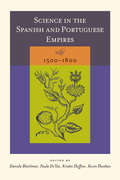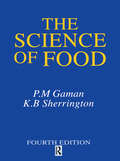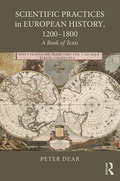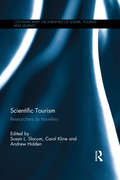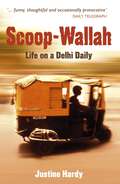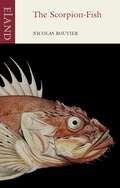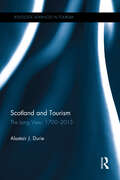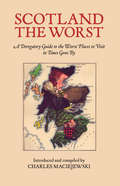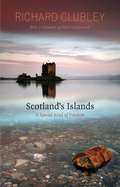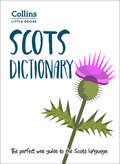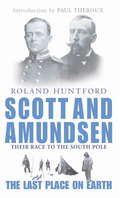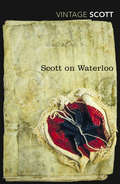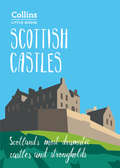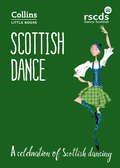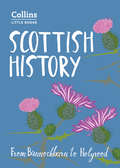- Table View
- List View
Science in the Spanish and Portuguese Empires, 1500–1800
by Daniela Bleichmar Paula De Vos Kristin Huffine Kevin SheehanThis collection of essays is the first book published in English to provide a thorough survey of the practices of science in the Spanish and Portuguese empires from 1500 to 1800. Authored by an interdisciplinary team of specialists from the United States, Latin America, and Europe, the book consists of fifteen original essays, as well as an introduction and an afterword by renowned scholars in the field. The topics discussed include navigation, exploration, cartography, natural sciences, technology, and medicine. This volume is aimed at both specialists and non-specialists, and is designed to be useful for teaching. It will be a major resource for anyone interested in colonial Latin America.
Science of Food
by K. B. Sherrington P. M. GamanFirst Published in 1998. Routledge is an imprint of Taylor & Francis, an informa company.
Science of Food: An Introduction To Food Science, Nutrition And Microbiology
by K. B. Sherrington P. M. GamanFirst Published in 1998. Routledge is an imprint of Taylor & Francis, an informa company.
Scientific Practices in European History, 1200-1800: A Book of Texts
by Peter DearScientific Practices in European History, 1200–1800 presents and situates a collection of extracts from both widely known texts by such figures as Copernicus, Newton, and Lavoisier, and lesser known but significant items, all chosen to provide a perspective on topics in social, cultural and intellectual history and to illuminate the concerns of the early modern period. The selection of extracts highlights the emerging technical preoccupations of this period, while the accompanying introductions and annotations make these occasionally complex works accessible to students and non-specialists. The book follows a largely chronological sequence and helps to locate scientific ideas and practices within broader European history. The primary source materials in this collection stand alone as texts in themselves, but in illustrating the scientific components of early modern societies they also make this book ideal for teachers and students of European history.
Scientific Practices in European History, 1200-1800: A Book of Texts
by Peter DearScientific Practices in European History, 1200–1800 presents and situates a collection of extracts from both widely known texts by such figures as Copernicus, Newton, and Lavoisier, and lesser known but significant items, all chosen to provide a perspective on topics in social, cultural and intellectual history and to illuminate the concerns of the early modern period. The selection of extracts highlights the emerging technical preoccupations of this period, while the accompanying introductions and annotations make these occasionally complex works accessible to students and non-specialists. The book follows a largely chronological sequence and helps to locate scientific ideas and practices within broader European history. The primary source materials in this collection stand alone as texts in themselves, but in illustrating the scientific components of early modern societies they also make this book ideal for teachers and students of European history.
Scientific Tourism: Researchers as Travellers (Contemporary Geographies of Leisure, Tourism and Mobility)
by Susan Slocum Carol Kline Andrew HoldenAs researchers in emerging economies, scientists are often the first foreign visitors to stay in remote rural areas and, on occasion, form joint venture ecotourism and community tourism projects or poverty alleviation schemes between local agencies or NGOs, the local community, and their home institution or agency. They therefore can contribute to avenues for the conservation of natural resources and the development of rural communities as well as influencing the future tourism development through its perceived legitimacy and the destination image it promotes. This book for the first time critically reviews tourism debates surrounding this emerging market of scientific and research oriented tourism. It is divided into three inter-related sections. Section 1 sets the stage of the discourse of scientific research in tourism; Section 2 evaluates the key players of scientific tourism looking particularly at the roles of NGOs, government agencies and university academic staff and Section 3 contains case studies documenting the niche of researchers as travelers in a range of geographical locations including Tanzania, Australia, Chile, Peru and Mexico. The title’s multidisciplinary approach provides an informed, interesting and stimulating addition to the existing limited literature and raises many issues and associated questions including the role of science tourism in tourism development and expansion, the impacts of scientific and research-based tourism, travel behaviors and motivations of researchers to name but a few. This significant volume will provide the reader with a better understanding of scientists as travelers, their relationship to the tourism industry, and the role they play in community development around tourism sites. It will be valuable reading for students and academics across the fields of Tourism, Geography and Development Studies as well as other social science disciplines.
Scientific Tourism: Researchers as Travellers (Contemporary Geographies of Leisure, Tourism and Mobility)
by Susan L. Slocum Carol Kline Andrew HoldenAs researchers in emerging economies, scientists are often the first foreign visitors to stay in remote rural areas and, on occasion, form joint venture ecotourism and community tourism projects or poverty alleviation schemes between local agencies or NGOs, the local community, and their home institution or agency. They therefore can contribute to avenues for the conservation of natural resources and the development of rural communities as well as influencing the future tourism development through its perceived legitimacy and the destination image it promotes. This book for the first time critically reviews tourism debates surrounding this emerging market of scientific and research oriented tourism. It is divided into three inter-related sections. Section 1 sets the stage of the discourse of scientific research in tourism; Section 2 evaluates the key players of scientific tourism looking particularly at the roles of NGOs, government agencies and university academic staff and Section 3 contains case studies documenting the niche of researchers as travelers in a range of geographical locations including Tanzania, Australia, Chile, Peru and Mexico. The title’s multidisciplinary approach provides an informed, interesting and stimulating addition to the existing limited literature and raises many issues and associated questions including the role of science tourism in tourism development and expansion, the impacts of scientific and research-based tourism, travel behaviors and motivations of researchers to name but a few. This significant volume will provide the reader with a better understanding of scientists as travelers, their relationship to the tourism industry, and the role they play in community development around tourism sites. It will be valuable reading for students and academics across the fields of Tourism, Geography and Development Studies as well as other social science disciplines.
Scoop-Wallah: Life on a Delhi Daily
by Justine HardyA chance conversation with her greengrocer about the media’s portrayal of India inspired journalist Justine Hardy to leave London and, following in the footsteps of Rudyard Kipling, spend a year working at The Indian Express in New Delhi. Her new life takes her all over India from polo matches and Assam tea gardens to city slums.
The Scorpion-Fish
by Nicolas BouvierOn an unamed Island that can only be Ceylon, the traveller checks into his 117th rented room, abandoned by his lover, poor and feverish. A book on Indian insects deepens his morbid fascination with the crawling inhabitants of the room-'a pretty world of killers'- barely distinguishable from the insect like habitues of the local cafe, the charlatans and fake exorcists, the indolent landowners, merchants and priests. In this exhausted state, he grows antennae that are 'tensed between the real and the occult'. The distinction between fact and fiction is blurred, but in this world of the imagination truths are sometimes crystal clear. A long-dead, levitating priest and the beautiful but deadly scorpion-fish, symbol of Bouvier's ambivalent relationship with the Island, are but two of the specters which eventually lose their hold on the author, releasing him back to life. It is a classic tale of the mental breakdown of a western traveller in the feverish heat of the tropical East - but which yet offers precious insights into the world and the self.
Scotland and Tourism: The Long View, 1700–2015 (Routledge Advances in Tourism)
by Alastair J. DurieTourism has long been important to Scotland. It has become all the more significant as the financial sector has faltered and other mainstays are in apparent long-term decline. Yet there is no assessment of this industry and its place over the long run, no one account of what it has meant to previous generations and continues to mean to the present one, of what led to growth or what indeed has led people of late to look elsewhere. This book brings together work from many periods and perspectives. It draws on a wide range of source material, academic and non-academic, from local studies and general analyses, visitors’ accounts, hotel records, newspaper and journal commentaries, photographs and even cartoons. It reviews arguments over the cultural and economic impact of tourism, and retrieves the experience of the visited, of the host communities as well as the visitors. It questions some of the orthodoxies – that Scott made Scott-land, or that it was charter air flights that pulled the rug from under the mass market – and sheds light on what in the Scottish package appealed, and what did not, and to whom; how provision changed, or failed to change; and what marketing strategies may have achieved. It charts changes in accommodation, from inn to hotel, holiday camp, caravanning and timeshare. The role of transport is a central feature: that of the steamship and the railway in opening up Scotland, and later of motor transport in reshaping patterns of holidaymaking. Throughout there is an emphasis on the comparative: asking what was distinctive about the forms and nature of tourism in Scotland as against competing destinations elsewhere in the UK and Europe. It concludes by reflecting on whether Scotland's past can inform the making and shaping of tourism policy and what cautions history might offer for the future. This prolific long-term analysis of tourism in Scotland is a must-read for all those interested in tourism history.
Scotland and Tourism: The Long View, 1700–2015 (Routledge Advances in Tourism)
by Alastair J. DurieTourism has long been important to Scotland. It has become all the more significant as the financial sector has faltered and other mainstays are in apparent long-term decline. Yet there is no assessment of this industry and its place over the long run, no one account of what it has meant to previous generations and continues to mean to the present one, of what led to growth or what indeed has led people of late to look elsewhere. This book brings together work from many periods and perspectives. It draws on a wide range of source material, academic and non-academic, from local studies and general analyses, visitors’ accounts, hotel records, newspaper and journal commentaries, photographs and even cartoons. It reviews arguments over the cultural and economic impact of tourism, and retrieves the experience of the visited, of the host communities as well as the visitors. It questions some of the orthodoxies – that Scott made Scott-land, or that it was charter air flights that pulled the rug from under the mass market – and sheds light on what in the Scottish package appealed, and what did not, and to whom; how provision changed, or failed to change; and what marketing strategies may have achieved. It charts changes in accommodation, from inn to hotel, holiday camp, caravanning and timeshare. The role of transport is a central feature: that of the steamship and the railway in opening up Scotland, and later of motor transport in reshaping patterns of holidaymaking. Throughout there is an emphasis on the comparative: asking what was distinctive about the forms and nature of tourism in Scotland as against competing destinations elsewhere in the UK and Europe. It concludes by reflecting on whether Scotland's past can inform the making and shaping of tourism policy and what cautions history might offer for the future. This prolific long-term analysis of tourism in Scotland is a must-read for all those interested in tourism history.
Scotland the Worst: A Derogatory Guide of the Worst Places to Visit in Times Gone By
by Charles MaciejewskiAn alternative guide to our bonnie wee country and its inhabitants, this book is a compendium of the less generous comments made by 17th, 18th and 19th century visitors. Hopefully much has changed – and mostly for the better!
Scotland's Islands: A Special Kind of Freedom
by Richard ClubleyThis is not a guide to the islands of Scotland. This is not a tour to be followed, nor is it travel advice. This is a richly anecdotal and personal exploration. Richard Clubley shares the sense of freedom he finds in the Scottish islands as he discovers their individual character, beauty and diversity. He meets locals and learns a few realities of island life. He almost perished on Ailsa Craig, before finding fresh water dripping from the roof of a cave, but spends two idyllic nights alone on Mingulay, with a fabulous coal fire in a bothy. His passion for Scottish islands shines through every chapter. Curl up by the fire, pull the blanket close and sip on your dram. You're about to escape to the islands. Prepare for addiction. A book for islomanes to savour in sips. Night caps are suggested; that way the addiction can be controlled. MAIRI HEDDERWICK
Scots Dictionary: Collins Little Books (Collins Little Books)
by Collins DictionariesA highly popular and informative guide to the Scots language in an attractive format. Contains words and phrases from both literary and everyday language, this is the perfect wee dictionary of Scots for native and non-native speakers alike.
Scott And Amundsen: The Last Place on Earth (Exploration Ser.)
by Roland HuntfordAt the beginning of the twentieth century, the South Pole was the most coveted prize in the fiercely nationalistic modern age of exploration. In the brilliant dual biography, the award-winning writer Roland Huntford re-examines every detail of the great race to the South Pole between Britain's Robert Scott and Norway's Roald Amundsen. Scott, who dies along with four of his men only eleven miles from his next cache of supplies, became Britain's beloved failure, while Amundsen, who not only beat Scott to the Pole but returned alive, was largely forgotten. This account of their race is a gripping, highly readable history that captures the driving ambitions of the era and the complex, often deeply flawed men who were charged with carrying them out.THE LAST PLACE ON EARTH is the first of Huntford's masterly trilogy of polar biographies. It is also the only work on the subject in the English language based on the original Norwegian sources, to which Huntford returned to revise and update this edition.
Scott on Waterloo (Virago Modern Classics)
by Sir Walter Scott Paul O'KeeffeOn the 200th anniversary of the Battle of Waterloo discover a fascinating primary source: Walter Scott's accounts of his journey to the battlefieldIn the immediate aftermath of the Battle of Waterloo tourists flocked from Britain to witness the scene of the most important conflict of their generation. Walter Scott was among them, and with a commission from his publisher for a travel book and a long poem. These prose and verse accounts bring to vivid life the carnage, spectacle and excitement of a fascinating period of European history. Brilliantly introduced and annotated by Paul O'Keeffe, this edition elucidates and contextualises Scott's first-hand account of his travels, his dashing epic, ‘The Field of Waterloo’ and the eerily chilling 'Dance of Death'.
Scottish Aviation Jetstream - Twin-engined Pilot Trainer (large print)
by RnibThis is an image of an aircraft seen from above. There is a locator dot shown, which will be at the top left of the page when the image is the correct way up. The image is in the centre and a scale in metres on the left of the page. The aircraft's nose is in the top centre and the tail in the bottom centre of the page. The fuselage goes up and down the middle of the page. The cockpit is shown as a curved window near the nose. The wings go out to the left and right. Sticking out from the front edge of each wing there is an engine with a propeller to the left and right of the fuselage. The bottom edge of the wing has three flaps on each side and the tail wing has one flap on each side. These are the ailerons used to manoeuvre the aircraft when it is flying. The tailplane has a long vertical tail which starts to rise from the fuselage just down from the centre of the image. The tail wing sticks out from the vertical tail halfway up it. The tips of the main wings and the leading half of the tailplane are red. The upper half of the fuselage is red, apart from the nose only a small part of this can be seen. The roof is white. The textures on the tactile image reflect structure not colour. There is a different texture for cockpit, wings, fuselage and engine.
Scottish Aviation Jetstream - Twin-engined Pilot Trainer (UEB contracted)
by RnibThis is an image of an aircraft seen from above. There is a locator dot shown, which will be at the top left of the page when the image is the correct way up. The image is in the centre and a scale in metres on the left of the page. The aircraft's nose is in the top centre and the tail in the bottom centre of the page. The fuselage goes up and down the middle of the page. The cockpit is shown as a curved window near the nose. The wings go out to the left and right. Sticking out from the front edge of each wing there is an engine with a propeller to the left and right of the fuselage. The bottom edge of the wing has three flaps on each side and the tail wing has one flap on each side. These are the ailerons used to manoeuvre the aircraft when it is flying. The tailplane has a long vertical tail which starts to rise from the fuselage just down from the centre of the image. The tail wing sticks out from the vertical tail halfway up it. The tips of the main wings and the leading half of the tailplane are red. The upper half of the fuselage is red, apart from the nose only a small part of this can be seen. The roof is white. The textures on the tactile image reflect structure not colour. There is a different texture for cockpit, wings, fuselage and engine.
Scottish Aviation Jetstream - Twin-engined Pilot Trainer (UEB uncontracted)
by RnibThis is an image of an aircraft seen from above. There is a locator dot shown, which will be at the top left of the page when the image is the correct way up. The image is in the centre and a scale in metres on the left of the page. The aircraft's nose is in the top centre and the tail in the bottom centre of the page. The fuselage goes up and down the middle of the page. The cockpit is shown as a curved window near the nose. The wings go out to the left and right. Sticking out from the front edge of each wing there is an engine with a propeller to the left and right of the fuselage. The bottom edge of the wing has three flaps on each side and the tail wing has one flap on each side. These are the ailerons used to manoeuvre the aircraft when it is flying. The tailplane has a long vertical tail which starts to rise from the fuselage just down from the centre of the image. The tail wing sticks out from the vertical tail halfway up it. The tips of the main wings and the leading half of the tailplane are red. The upper half of the fuselage is red, apart from the nose only a small part of this can be seen. The roof is white. The textures on the tactile image reflect structure not colour. There is a different texture for cockpit, wings, fuselage and engine.
Scottish Aviation Twin Pioneer- STOL Tactical Light Transport (large print)
by RnibThis is an image of an aircraft seen from above. There is a locator dot shown, which will be at the top left of the page when the image is the correct way up. The image is in the centre and a scale in metres on the left of the page. The aircraft's nose is in the top centre and the tail in the bottom centre of the page. The fuselage goes up and down the middle of the page. The cockpit is shown as two small windows near the nose. The wings go out to the left and right. Sticking out from the front edge of each wing is an engine with propellers, to the left and right of the fuselage. The bottom edge of the wing has three flaps on each side and the tail wing has one flap on each side. These are the ailerons used to manoeuvre the aircraft when it is flying. The tailplane has three vertical tails, one in the middle and one to either side. The tips of the main wings and the leading half of the tailplane are red. The upper half of the fuselage is red, apart from the nose only a small part of this can be seen. The roof is white. The textures on the tactile image reflect structure not colour. There is a different texture for the cockpit, wings, fuselage and engine.
Scottish Aviation Twin Pioneer- STOL Tactical Light Transport (UEB contracted)
by RnibThis is an image of an aircraft seen from above. There is a locator dot shown, which will be at the top left of the page when the image is the correct way up. The image is in the centre and a scale in metres on the left of the page. The aircraft's nose is in the top centre and the tail in the bottom centre of the page. The fuselage goes up and down the middle of the page. The cockpit is shown as two small windows near the nose. The wings go out to the left and right. Sticking out from the front edge of each wing is an engine with propellers, to the left and right of the fuselage. The bottom edge of the wing has three flaps on each side and the tail wing has one flap on each side. These are the ailerons used to manoeuvre the aircraft when it is flying. The tailplane has three vertical tails, one in the middle and one to either side. The tips of the main wings and the leading half of the tailplane are red. The upper half of the fuselage is red, apart from the nose only a small part of this can be seen. The roof is white. The textures on the tactile image reflect structure not colour. There is a different texture for the cockpit, wings, fuselage and engine.
Scottish Aviation Twin Pioneer- STOL Tactical Light Transport (UEB uncontracted)
by RnibThis is an image of an aircraft seen from above. There is a locator dot shown, which will be at the top left of the page when the image is the correct way up. The image is in the centre and a scale in metres on the left of the page. The aircraft's nose is in the top centre and the tail in the bottom centre of the page. The fuselage goes up and down the middle of the page. The cockpit is shown as two small windows near the nose. The wings go out to the left and right. Sticking out from the front edge of each wing is an engine with propellers, to the left and right of the fuselage. The bottom edge of the wing has three flaps on each side and the tail wing has one flap on each side. These are the ailerons used to manoeuvre the aircraft when it is flying. The tailplane has three vertical tails, one in the middle and one to either side. The tips of the main wings and the leading half of the tailplane are red. The upper half of the fuselage is red, apart from the nose only a small part of this can be seen. The roof is white. The textures on the tactile image reflect structure not colour. There is a different texture for the cockpit, wings, fuselage and engine.
Scottish Castles: Scotland’s most dramatic castles and strongholds (Collins Little Books)
by Chris TabrahamA handy guide to nearly 140 of Scotland’s most dramatic castles and strongholds, all of which are open to the public.Optimised for colour tablets. The images in this ebook are not suitable for viewing on black and white e-ink devices.
Scottish Dance: A celebration of Scottish dancing (Collins Little Books)
by The Royal Scottish Country Dance SocietyA perfect introduction to the world of Scottish dance written by the Royal Scottish Country Dance Society, including a short history of Scottish dancing. The book takes you through simple ceilidh moves to more complex formations and set dances, illustrated through diagrams and photos.
Scottish History: From Bannockburn To Holyrood (Collins Little Books)
by John AbernethyFrom prehistoric Scotland to the Brexit referendum, this little book covers all of the main events in Scottish history.
